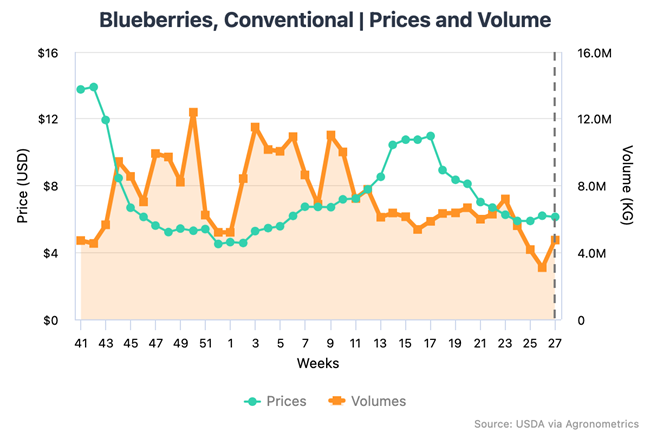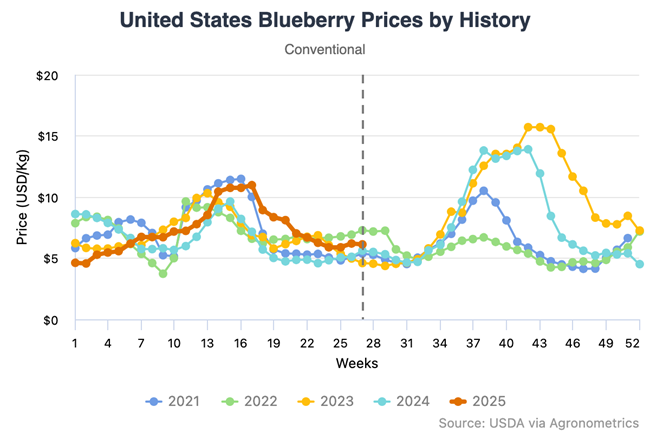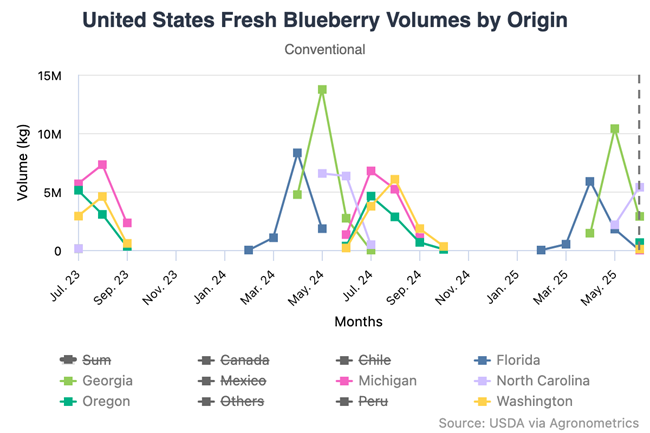Agronometrics in Charts: Sweet, blue, and worth $9B
- . July 2025
July is National Blueberry Month, and this year, the celebration comes with serious numbers behind it. According to the U.S. Highbush Blueberry Council’s 2025 Impact Report, blueberries generate an estimated $9.1 billion in total economic impact across the U.S. economy annually. That figure includes everything from farming and packing to transportation, marketing, and foodservice. In total, the blueberry sector supports more than 61,676 full-time equivalent jobs and delivers $3.3 billion in labor income. “The economic impact of blueberry growers is both far-reaching and deeply rooted in the US economy,” says Kasey Cronquist, president of the USHBC. “From job creation to tax revenue, blueberry growers fuel sustained economic activity in every region of the country.”
Key harvests peak in July across Michigan, Oregon, New Jersey, and Washington, but imports are just as essential, especially during the fall and winter months. Countries like Peru and Mexico now make up a large percentage of total U.S. blueberry supply annually, keeping grocery shelves stocked when domestic production slows.
Pricing in week 27 was around $6.13 per kg, up 9% from $5.62 in 2024. Retail data shows a surge in promotional activity during July, with retail ad volume peaking across major chains. Consumer habits reflect the fruit’s popularity. A 2025 consumer survey showed that 54% of U.S. shoppers bought blueberries in the past year, up from 37% just two years ago. The West and Midwest lead in consumption, and higher-income households are most likely to buy frequently. Organic blueberries are gaining traction, too, with 20% of consumers preferring them and another 24% buying both organic and conventional options depending on availability and price.
On the supply side, growers are turning to technology to stay ahead. The USHBC’s BerrySmart Fields program is helping promote ag-tech adoption across the industry, from drone imaging and precision irrigation to robotic harvesters and automated packlines. These innovations are critical for addressing labor shortages and improving productivity at scale. They also highlight how the blueberry sector is investing not just in growth, but in resilience and efficiency.
What makes blueberries unique among fruit crops is their strategic position at the intersection of seasonality, supply chain agility, and evolving consumer preference. Domestic production dominates the summer, while imports backfill the rest of the year. This balance allows for consistent retail presence and economic continuity. As National Blueberry Month reminds us, the value of this fruit isn’t just in its flavor or nutritional profile, it’s in the far-reaching economic engine it fuels.



07-15-2025
Source: Freshfruitportal.com







